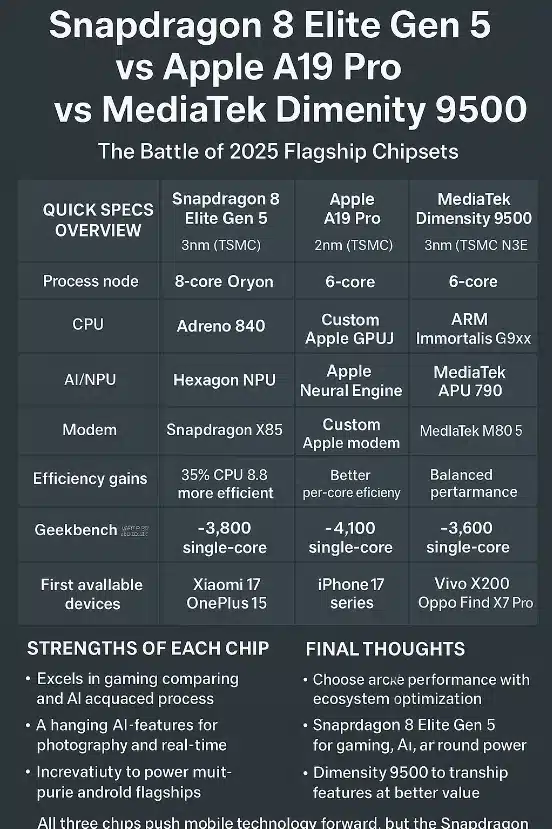Smartphone processors are becoming as powerful as laptop chips, and 2025 has already given us three major flagships: Qualcomm Snapdragon 8 Elite Gen 5, Apple A19 Pro, and MediaTek Dimensity 9500. Each chip has strengths in performance, AI, and efficiency. Here’s a clear comparison.
Snapdragon 8 Elite Gen 5
Qualcomm’s Snapdragon 8 Elite Gen 5 is built on TSMC’s 3nm N3P process. It introduces the third generation of Qualcomm’s Oryon CPU design. This architecture includes:
- 2 Prime cores clocked close to 4.6 GHz for extreme single-thread power.
- 6 performance cores at around 3.6 GHz for balanced speed and efficiency.
Graphics are handled by the Adreno 840 GPU, which offers 20–23% more performance while using less energy. Qualcomm also added hardware ray tracing and “Game Latency Reduction,” cutting online lag by up to 50%.
AI tasks are powered by the updated Hexagon NPU, delivering 37% more performance per watt. Combined with the Spectra ISP, this allows advanced computational photography, including professional video features and real-time scene enhancements.
Connectivity is handled by the Snapdragon X85 5G modem, which supports both mmWave and sub-6 GHz 5G, plus Wi-Fi 7.
Apple A19 Pro
Apple’s A19 Pro is the company’s first chip based on the 2nm TSMC process, giving it a major edge in efficiency. Its CPU design uses:
- 2 high-performance cores for maximum speed.
- 4 efficiency cores for background tasks.
Even with fewer cores, Apple optimizes performance through iOS integration. Benchmarks show the A19 Pro reaching 4,100+ single-core Geekbench scores, making it one of the fastest chips ever.
The Apple GPU offers better energy control with high-end rendering and gaming features. Apple also refined its Neural Engine, enabling faster on-device AI for Siri, image processing, and real-time translations.
As expected, the A19 Pro comes with Apple’s custom modem for 5G and Wi-Fi 7, designed to work seamlessly with iOS and hardware.
MediaTek Dimensity 9500
MediaTek’s Dimensity 9500 is built on TSMC’s 3nm N3E node. It balances performance and efficiency using:
- 1 Ultra core at ~4.2 GHz.
- 3 Super cores for demanding workloads.
- 4 efficiency cores for light operations.
The chipset features an Immortalis G9xx GPU, supporting ray tracing and AI-driven rendering optimizations. Its APU 790 neural processor accelerates AI tasks, giving it strong performance in real-world apps.
Connectivity comes from the M80 5G modem, with wide 5G coverage and Wi-Fi 7 support.
Quick Specs Overview
| Feature | Snapdragon 8 Elite Gen 5 | Apple A19 Pro | MediaTek Dimensity 9500 |
|---|---|---|---|
| Process Node | 3nm (TSMC N3P) | 2nm (TSMC) | 3nm (TSMC N3E) |
| CPU | 8-core Oryon (2× Prime up to 4.6 GHz, 6× Performance up to 3.6 GHz) | 6-core design (2× High-Performance, 4× Efficiency) | 8-core (1× Ultra core ~4.2 GHz, 3× Super cores, 4× Efficiency cores) |
| GPU | Adreno 840 (Ray Tracing, 20–23% faster) | Custom Apple GPU (better efficiency, strong gaming optimization) | ARM Immortalis G9xx (Ray Tracing, AI-enhanced rendering) |
| AI / NPU | Hexagon NPU, ~37% more efficient | Apple Neural Engine, optimized for iOS AI tasks | MediaTek APU 790, strong multi-core AI |
| Modem | Snapdragon X85 5G, Wi-Fi 7 | Custom Apple modem (5G, Wi-Fi 7 support) | MediaTek M80 5G modem |
| Efficiency Gains | 35% CPU efficiency, 16% overall | Better per-core efficiency (thanks to 2nm node) | Balanced performance with good thermal control |
| Geekbench (Leaked) | ~3,800 single-core | ~4,100 single-core | ~3,600 single-core |
| First Devices | Xiaomi 17, OnePlus 15 | iPhone 17 series | Vivo X200, Oppo Find X7 Pro |
Strengths of Each Chip
- Snapdragon 8 Elite Gen 5
- Excels in gaming with strong GPU and reduced latency.
- Advanced AI features for photography and real-time processing.
- More versatile, since it powers many Android flagships.
- Apple A19 Pro
- Best single-core performance, ideal for smooth iOS apps.
- Strong integration with Apple’s ecosystem (iOS + hardware).
- 2nm process gives better efficiency per watt.
- MediaTek Dimensity 9500
- Offers competitive performance at slightly lower cost.
- Efficient multi-core AI acceleration.
- Found in premium but often more affordable Android phones.
Final Thoughts
- If you want raw performance with ecosystem optimization, the Apple A19 Pro is on top.
- For gaming, AI, and all-round Android power, the Snapdragon 8 Elite Gen 5 leads the pack.
- If you want flagship features at better value, the Dimensity 9500 is an excellent choice.
All three chips push mobile technology forward, but the Snapdragon 8 Elite Gen 5 might have the widest impact because it will appear in multiple Android flagships across brands.
- iPhone 17 Pro Max Launch Date: 10 Reasons to Wait for iPhone 17 Series
- How to buy a perfect jacketcoat trouser | Josforup
- क्या BRICS देश मिलकर अपनी मुद्रा बना सकते है?
- Best Website Speed Test
- JPG to PNG to WEBP converter
- Convert Any File Into PDF
- Facts About Tomatoes That You May Not Know
- Age Calculator
- Vicky Kaushal & Katrina Kaif Announce Pregnancy: A New Chapter Begins

1 thought on “Snapdragon 8 Elite Gen 5 vs Apple A19 Pro vs MediaTek Dimensity 9500”